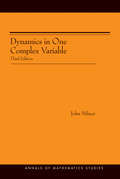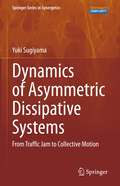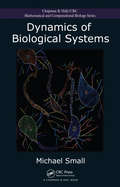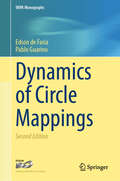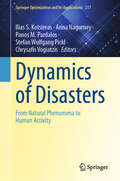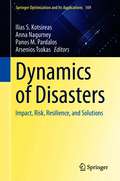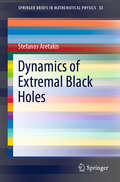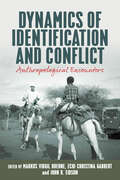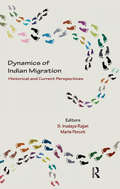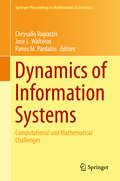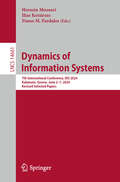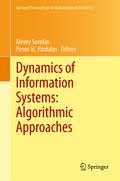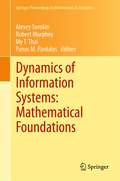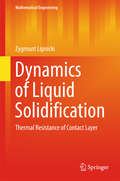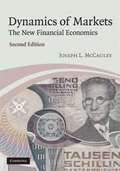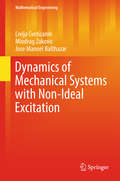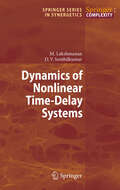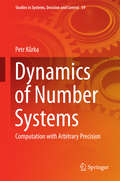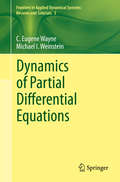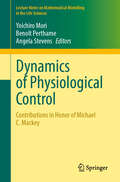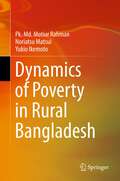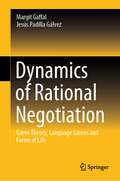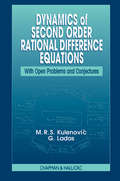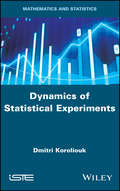- Table View
- List View
Dynamics in One Complex Variable. (AM-160): (AM-160)
by John MilnorThis volume studies the dynamics of iterated holomorphic mappings from a Riemann surface to itself, concentrating on the classical case of rational maps of the Riemann sphere. This subject is large and rapidly growing. These lectures are intended to introduce some key ideas in the field, and to form a basis for further study. The reader is assumed to be familiar with the rudiments of complex variable theory and of two-dimensional differential geometry, as well as some basic topics from topology. This third edition contains a number of minor additions and improvements: A historical survey has been added, the definition of Lattés map has been made more inclusive, and the écalle-Voronin theory of parabolic points is described. The résidu itératif is studied, and the material on two complex variables has been expanded. Recent results on effective computability have been added, and the references have been expanded and updated. Written in his usual brilliant style, the author makes difficult mathematics look easy. This book is a very accessible source for much of what has been accomplished in the field.
Dynamics of Asymmetric Dissipative Systems: From Traffic Jam to Collective Motion (Springer Series in Synergetics)
by Yuki SugiyamaThis book provides the dynamics of non-equilibrium dissipative systems with asymmetric interactions (Asymmetric Dissipative System; ADS). Asymmetric interaction breaks "the law of action and reaction" in mechanics, and results in non-conservation of the total momentum and energy. In such many-particle systems, the inflow of energy is provided and the energy flows out as dissipation. The emergences of non-trivial macroscopic phenomena occur in the non-equilibrium energy balance owing to the effect of collective motions as phase transitions and bifurcations. ADS are applied to the systems of self-driven interacting particles such as traffic and granular flows, pedestrians and evacuations, and collective movement of living systems. The fundamental aspects of dynamics in ADS are completely presented by a minimal mathematical model, the Optimal Velocity (OV) Model. Using that model, the basics of mathematical and physical mechanisms of ADS are described analytically with exact results. The application of 1-dimensional motions is presented for traffic jam formation. The mathematical theory is compared with empirical data of experiments and observations on highways. In 2-dimensional motion pattern formations of granular media, pedestrians, and group formations of organisms are described. The common characteristics of emerged moving objects are a variety of patterns, flexible deformations, and rapid response against stimulus. Self-organization and adaptation in group formations and control of group motions are shown in examples. Another OV Model formulated by a delay differential equation is provided with exact solutions using elliptic functions. The relations to soliton systems are described. Moreover, several topics in ADS are presented such as the similarity between the spatiotemporal patterns, violation of fluctuation dissipation relation, and a thermodynamic function for governing the phase transition in non-equilibrium stationary states.
Dynamics of Biological Systems (Chapman & Hall/CRC Computational Biology Series)
by Michael SmallFrom the spontaneous rapid firing of cortical neurons to the spatial diffusion of disease epidemics, biological systems exhibit rich dynamic behaviour over a vast range of time and space scales. Unifying many of these diverse phenomena, Dynamics of Biological Systems provides the computational and mathematical platform from which to understand the
Dynamics of Circle Mappings (IMPA Monographs)
by Pablo Guarino Edson de FariaThis book explores recent developments in the dynamics of invertible circle maps, a rich and captivating topic in one-dimensional dynamics. It focuses on two main classes of invertible dynamical systems on the circle: global diffeomorphisms and smooth homeomorphisms with critical points. The latter is the book's core, reflecting the authors' recent research interests.Organized into four parts and 14 chapters, the content covers rigid rotations, circle homeomorphisms, and the concept of rotation number in the first part. The second part delves into circle diffeomorphisms, presenting classical results. The third part introduces multicritical circle maps—smooth homeomorphisms of the circle with a finite number of critical points. The fourth and final part centers on renormalization theory, analyzing the fine geometric structure of orbits of multicritical circle maps. Complete proofs for several fundamental results in circle dynamics are provided throughout. The book concludes with a list of open questions.Primarily intended for graduate students and young researchers in dynamical systems, this book is also suitable for mathematicians from other fields with an interest in the subject. Prerequisites include familiarity with the content of a standard graduate course in real analysis, along with some understanding of ergodic theory and dynamical systems. Basic knowledge of complex analysis is needed for specific chapters.
Dynamics of Disasters: From Natural Phenomena to Human Activity (Springer Optimization and Its Applications #217)
by Panos M. Pardalos Ilias S. Kotsireas Anna Nagurney Chrysafis Vogiatzis Stefan Wolfgang PicklBased on the “Sixth International Conference on Dynamics of Disasters” (Piraeus, Greece, July 2023), this volume includes contributions from experts who share their latest discoveries on disasters either caused by natural phenomena or human activities. Authors provide overviews of the tactical points involved in disaster relief, outlines of hurdles from mitigation and preparedness to response and recovery and uses for mathematical models to describe disasters and their impacts. This volume includes additional invited manuscripts from other experts and leaders in the field. Topics covered include economics, optimization, machine learning, government, management, business, humanities, engineering, medicine, mathematics, computer science, behavioral studies, emergency services, and environmental studies and will engage readers from a wide variety of fields and backgrounds.
Dynamics of Disasters: Impact, Risk, Resilience, and Solutions (Springer Optimization and Its Applications #169)
by Panos M. Pardalos Ilias S. Kotsireas Anna Nagurney Arsenios TsokasBased on the “Fourth International Conference on Dynamics of Disasters” (Kalamata, Greece, July 2019), this volume includes contributions from experts who share their latest discoveries on natural and unnatural disasters. Authors provide overviews of the tactical points involved in disaster relief, outlines of hurdles from mitigation and preparedness to response and recovery, and uses for mathematical models to describe natural and man-made disasters. Topics covered include economics, optimization, machine learning, government, management, business, humanities, engineering, medicine, mathematics, computer science, behavioral studies, emergency services, and environmental studies will engage readers from a wide variety of fields and backgrounds.
Dynamics of Extremal Black Holes (SpringerBriefs in Mathematical Physics #33)
by Stefanos AretakisThis Brief presents in a self-contained, non-technical and illustrative fashion the state-of-the-art results and techniques for the dynamics of extremal black holes. Extremal black holes are, roughly speaking, either maximally rotating or maximally charged. Astronomical observations suggest that near-extremal (stellar or supermassive) black holes are ubiquitous in the universe. The book presents various recently discovered characteristic phenomena (such as the horizon instability) that have enhanced our understanding of the dynamics of extremal black holes. The topics should be of interest to pure mathematicians, theoretical physicists and astronomers. This book provides common ground for communication between these scientific communities.
Dynamics of Identification and Conflict: Anthropological Encounters
by John R. Eidson Markus Virgil Hoehne, Echi Christina GabbertDealing with the dynamics of identification and conflict, this book uses theoretical orientations ranging from political ecology to rational choice theory, interpretive approaches, Marxism and multiscalar analysis. Case studies set in Africa, Europe and Central Asia are grouped in three sections devoted to pastoralism, identity and migration. What connects all of these anthropological explorations is a close focus on processes of identification and conflict at the level of particular actors in relation to the behaviour of large aggregates of people and to systemic conditions.
Dynamics of Identification and Conflict: Anthropological Encounters
by Markus Virgil Hoehne, Echi Christina Gabbert, and John R. EidsonDealing with the dynamics of identification and conflict, this book uses theoretical orientations ranging from political ecology to rational choice theory, interpretive approaches, Marxism and multiscalar analysis. Case studies set in Africa, Europe and Central Asia are grouped in three sections devoted to pastoralism, identity and migration. What connects all of these anthropological explorations is a close focus on processes of identification and conflict at the level of particular actors in relation to the behaviour of large aggregates of people and to systemic conditions.
Dynamics of Indian Migration: Historical and Current Perspectives
by S. Irudaya RajanThis volume is a multidisciplinary approach to the subject of Indian international emigration and comprises contributions by demographers, economists, sociologists, geographers, anthropologists and historians. The book highlights emerging issues such as the political economy of international migration, skilled and unskilled migration, body shopping, return migration, immigration policies in the Gulf and experiences of emigrants from the states of Kerala and Punjab. It focuses on the current dimensions like skilled migrants in the IT sector of Malaysia, the entrepreneurial ventures of Keralites in the UAE, household remittances, inequality and poverty in Kerala, the gender dimension of Indian migration (with focus on nurses and housemaids in the Gulf) and cross-border migratory movements connected to the European Union, with an overview of the migration of Sikhs and Tamils to France. Finally, it carries a discussion of the evolution of India’s public policies towards its diaspora.
Dynamics of Information Systems
by Panos M. Pardalos Chrysafis Vogiatzis Jose L. WalterosThe contributions of this volume stem from the "Fifth International Conference on the Dynamics of Information Systems" held in Gainesville, FL in February 2013, and discuss state-of the-art techniques in handling problems and solutions in the broad field of information systems. Dynamics of Information Systems: Computational and Mathematical Challenges presents diverse aspects of modern information systems with an emphasis on interconnected network systems and related topics, such as signal and message reconstruction, network connectivity, stochastic network analysis, cyber and computer security, community and cohesive structures in complex networks. Information systems are a vital part of modern societies. They are essential to our daily actions, including social networking, business and bank transactions, as well as sensor communications. The rapid increase in these capabilities has enabled us with more powerful systems, readily available to sense, control, disperse, and analyze information.
Dynamics of Information Systems: 7th International Conference, DIS 2024, Kalamata, Greece, June 2–7, 2024, Revised Selected Papers (Lecture Notes in Computer Science #14661)
by Panos M. Pardalos Ilias Kotsireas Hossein MoosaeiThis post conference LNCS volume constitutes the proceedings of the 7th International Conference on Dynamics of Information Systems, DIS 2024, in Kalamata, Greece, took place in June 2024. The 19 full papers together included in this volume were carefully reviewed and selected from 40 submissions. The conference presents topics such as information systems, optimization, operations research, machine learning, and artificial intelligence.
Dynamics of Information Systems: Algorithmic Approaches
by Panos M. Pardalos Alexey SorokinDynamics of Information Systems: Algorithmic Approaches presents recent developments and results found by participants of the Fourth International Conference on the Dynamics of Information Systems, which took place at the University of Florida, Gainesville FL, USA on February 20-22, 2012. The purpose of this conference was to bring together scientists and engineers from industry, government, and universities to exchange knowledge and results in a broad range of topics relevant to the theory and practice of the dynamics of information systems. Dynamics of Information plays an increasingly critical role in our society. The influence of information on social, biological, genetic, and military systems must be better understood to achieve large advances in the capability and understanding of these systems. Applications are widespread and include: detection of terrorist networks, design of highly efficient businesses, computer networks, quantum entanglement, genome modeling, multi-robotic systems, and industrial and manufacturing safety. The book contains state-of-the-art work on theory and practice relevant to the dynamics of information systems. It covers algorithmic approaches to numerical computations with infinite and infinitesimal numbers; presents important problems arising in service-oriented systems, such as dynamic composition and analysis of modern service-oriented information systems and estimation of customer service times on a rail network from GPS data; addresses the complexity of the problems arising in stochastic and distributed systems; and discusses modulating communication for improving multi-agent learning convergence. Network issues--in particular minimum-risk maximum-clique problems, vulnerability of sensor networks, influence diffusion, community detection, and link prediction in social network analysis, as well as a comparative analysis of algorithms for transmission network expansion planning--are described in later chapters.
Dynamics of Information Systems: Mathematical Foundations
by Panos M. Pardalos My T. Thai Robert Murphey Alexey SorokinThis book presents recent developments and results found by participants of the Third International Conference on the Dynamics of Information Systems, which took place at the University of Florida, Gainesville FL, USA on February 16-18, 2011. The purpose of this conference was to bring together scientists and engineers from industry, government, and universities to exchange knowledge and results in a broad range of topics relevant to the theory and practice of the dynamics of information systems. Dynamics of Information plays an increasingly critical role in our society. The influence of information on social, biological, genetic, and military systems must be better understood to achieve large advances in the capability and understanding of these systems. Applications are widespread and include: research in evolutionary theory, optimization of information workflow, military applications, climate networks, collision work, and much more. Dynamics of Information plays an increasingly critical role in our society. The influence of information on social, biological, genetic, and military systems must be better understood to achieve large advances in the capability and understanding of these systems. Applications are widespread and include: research in evolutionary theory, optimization of information workflow, military applications, climate networks, collision work, and much more.
Dynamics of Liquid Solidification
by Zygmunt LipnickiThis monograph comprehensively describes phenomena of heat flow during phase change as well as the dynamics of liquid solidification, i. e. the development of a solidified layer. The book provides the reader with basic knowledge for practical designs, as well as with equations which describe processes of energy transformation. The target audience primarily comprises researchers and experts in the field of heat flow, but the book may also be beneficial for both practicing engineers and graduate students.
Dynamics of Markets: The New Financial Economics (2nd edition)
by Joseph L. MccauleyThis second edition presents the advances made in finance market analysis since 2005. The book provides a careful introduction to stochastic methods along with approximate ensembles for a single, historic time series. The new edition explains the history leading up to the biggest economic disaster of the 21st century. Empirical evidence for finance market instability under deregulation is given, together with a history of the explosion of the US Dollar worldwide. A model shows how bounds set by a central bank stabilized FX in the gold standard era, illustrating the effect of regulations. The book presents economic and finance theory thoroughly and critically, including rational expectations, cointegration and arch/garch methods, and replaces several of those misconceptions by empirically based ideas. This book will be of interest to finance theorists, traders, economists, physicists and engineers, and leads the reader to the frontier of research in time series analysis.
Dynamics of Mechanical Systems with Non-Ideal Excitation
by Livija Cveticanin Miodrag Zukovic Jose Manoel BalthazarIn this book the dynamics of the non-ideal oscillatory system, in which the excitation is influenced by the response of the oscillator, is presented. Linear and nonlinear oscillators with one or more degrees of freedom interacting with one or more energy sources are treated. This concerns for example oscillating systems excited by a deformed elastic connection, systems excited by an unbalanced rotating mass, systems of parametrically excited oscillator and an energy source, frictionally self-excited oscillator and an energy source, energy harvesting system, portal frame – non-ideal source system, non-ideal rotor system, planar mechanism – non-ideal source interaction. For the systems the regular and irregular motions are tested. The effect of self-synchronization, chaos and methods for suppressing chaos in non-ideal systems are considered. In the book various types of motion control are suggested. The most important property of the non-ideal system connected with the jump-like transition from a resonant state to a non-resonant one is discussed. The so called ‘Sommerfeld effect’, resonant unstable state and jumping of the system into a new stable state of motion above the resonant region is explained. A mathematical model of the system is solved analytically and numerically. Approximate analytical solving procedures are developed. Besides, simulation of the motion of the non-ideal system is presented. The obtained results are compared with those for the ideal case. A significant difference is evident. The book aims to present the established results and to expand the literature in non-ideal vibrating systems. A further intention of the book is to give predictions of the effects for a system where the interaction between an oscillator and the energy source exist. The book is targeted at engineers and technicians dealing with the problem of source-machine system, but is also written for PhD students and researchers interested in non-linear and non-ideal problems.
Dynamics of Nonlinear Time-Delay Systems
by Dharmapuri Vijayan Senthilkumar Muthusamy LakshmananSynchronization of chaotic systems, a patently nonlinear phenomenon, has emerged as a highly active interdisciplinary research topic at the interface of physics, biology, applied mathematics and engineering sciences. In this connection, time-delay systems described by delay differential equations have developed as particularly suitable tools for modeling specific dynamical systems. Indeed, time-delay is ubiquitous in many physical systems, for example due to finite switching speeds of amplifiers in electronic circuits, finite lengths of vehicles in traffic flows, finite signal propagation times in biological networks and circuits, and quite generally whenever memory effects are relevant. This monograph presents the basics of chaotic time-delay systems and their synchronization with an emphasis on the effects of time-delay feedback which give rise to new collective dynamics. Special attention is devoted to scalar chaotic/hyperchaotic time-delay systems, and some higher order models, occurring in different branches of science and technology as well as to the synchronization of their coupled versions. Last but not least, the presentation as a whole strives for a balance between the necessary mathematical description of the basics and the detailed presentation of real-world applications.
Dynamics of Number Systems
by Petr KůrkaThis book is a source of valuable and usefulinformation on the topics of dynamics of number systems and scientificcomputation with arbitrary precision. It is addressed to scholars, scientistsand engineers, and graduate students. The treatment is elementary andself-contained with relevance both for theory and applications. The basicprerequisite of the book is linear algebra and matrix calculus.
Dynamics of Partial Differential Equations
by C. Eugene Wayne Michael I. WeinsteinThis book contains two review articles on the dynamics of partial differential equations that deal with closely related topics but can be read independently. Wayne reviews recent results on the global dynamics of the two-dimensional Navier-Stokes equations. This system exhibits stable vortex solutions: the topic of Wayne's contribution is how solutions that start from arbitrary initial conditions evolve towards stable vortices. Weinstein considers the dynamics of localized states in nonlinear Schrodinger and Gross-Pitaevskii equations that describe many optical and quantum systems. In this contribution, Weinstein reviews recent bifurcations results of solitary waves, their linear and nonlinear stability properties and results about radiation damping where waves lose energy through radiation. The articles, written independently, are combined into one volume to showcase the tools of dynamical systems theory at work in explaining qualitative phenomena associated with two classes of partial differential equations with very different physical origins and mathematical properties.
Dynamics of Physiological Control: Contributions in Honor of Michael C. Mackey (Lecture Notes on Mathematical Modelling in the Life Sciences)
by Benoît Perthame Angela Stevens Yoichiro MoriThis book provides an overview of recent mathematical models for dynamics in cellular systems and offers a unique vision of the field by prominent experts. It covers, among others, the regulatory basis of oscillations in biological systems; ergodic and chaotic properties in biological models with the example of maturity distribution of precursors of blood cells; time-delayed feedbacks; mathematical models of cell division and heterogeneous stem cell regeneration; quantitative mathematical modeling of glucose regulation; data-driven models of chemotherapy-induced neutropenia; and effects of irradiation and antioxidants in Alzheimer’s disease. This book is directed towards mathematicians interested in learning about modeling in cellular systems and is accessible also to theoreticians in biology and medicine.
Dynamics of Poverty in Rural Bangladesh
by Noriatsu Matsui Yukio Ikemoto Pk. Md. RahmanThe study of poverty dynamics is important for effective poverty alleviation policies because the changes in income poverty are also accompanied by changes in socioeconomic factors such as literacy, gender parity in school, health care, infant mortality, and asset holdings. In order to examine the dynamics of poverty, information from 1,212 households in 32 rural villages in Bangladesh was collected in December 2004 and December 2009. This book reports the analytical results from quantitative and qualitative surveys from the same households at two points of time, which yielded the panel data for understanding the changes in situations of poverty. Efforts have been made to include the most recent research from diverse disciplines including economics, statistics, anthropology, education, health care, and vulnerability study. Specifically, findings from logistic regression analysis, polychoric principal component analysis, kernel density function, income mobility with the help of the Markov chain model, and child nutrition status from anthropometric measures have been presented. Asset holdings and liabilities of the chronically poor as well as those of three other economic groups (the descending non-poor, the ascending poor, and the non-poor) are analyzed statistically. The degrees of vulnerability to poverty are examined by years of schooling, landholding size, gender of household head, social capital, and occupation. The multiple logistic regression model was used to identify important risk factors for a household's vulnerability. In 2009, some of the basic characteristics of the chronically poor were: higher percentage and number of female-headed households, higher dependency ratio, lower levels of education, fewer years of schooling, and limited employment. There was a low degree of mobility of households from one poverty status to another in the period 2004-2009, implying that the process of economic development and high economic growth in the macroeconomy during this time failed to improve the poverty situation in rural Bangladesh.
Dynamics of Rational Negotiation: Game Theory, Language Games and Forms of Life
by Margit Gaffal Jesús Padilla GálvezThis book uses game theory to analyze the strategies developed in negotiation processes. Offering a detailed analysis of competition and cooperation, it explores various bargaining strategies that result from the application of Nash equilibrium and mixed strategies. Employing a blend of game theory and real-world examples, the authors describe typical negotiation scenarios and unveil the art of negotiation strategy – dissecting both competitive and cooperative tactics.This comprehensive analysis explores the multifaceted dimensions of negotiation, highlighting not only formal aspects but also the economic, social, political, and human factors at play. The authors discuss the basic structures of cooperative and non-cooperative games and conduct a comprehensive analysis of the language games that take place in negotiations. They examine how negotiators belonging to different forms of life can trade with each other when their respective language games are different and prone to misinterpretation. The book also probes arbitration and mediation as conflict-resolution tools within this intricate landscape. Designed for the curious minds seeking insight into negotiation strategies, as well as students and scholars of diverse fields, this book fosters an understanding of negotiation's labyrinthine pathways. "Dynamics of Rational Negotiation" unlocks the door to negotiation's complexities, inviting readers to unravel the layers of human interaction.
Dynamics of Second Order Rational Difference Equations: With Open Problems and Conjectures
by G. Ladas Mustafa R.S. KulenovicThis self-contained monograph provides systematic, instructive analysis of second-order rational difference equations. After classifying the various types of these equations and introducing some preliminary results, the authors systematically investigate each equation for semicycles, invariant intervals, boundedness, periodicity, and global stabili
Dynamics of Statistical Experiments
by Dmitri KorolioukThis book is devoted to the system analysis of statistical experiments, determined by the averaged sums of sampling random variables. The dynamics of statistical experiments are given by difference stochastic equations with a speci?ed regression function of increments – linear or nonlinear. The statistical experiments are studied by the sample volume increasing (N ??), as well as in discrete-continuous time by the number of stages increasing (k ??) for different conditions imposed on the regression function of increments. The proofs of limit theorems employ modern methods for the operator and martingale characterization of Markov processes, including singular perturbation methods. Furthermore, they justify the representation of a stationary Gaussian statistical experiment with the Markov property, as a stochastic difference equation solution, applying the theorem of normal correlation. The statistical hypotheses verification problem is formulated in the classification of evolutionary processes, which determine the dynamics of the predictable component. The method of stochastic approximation is used for classifying statistical experiments.
